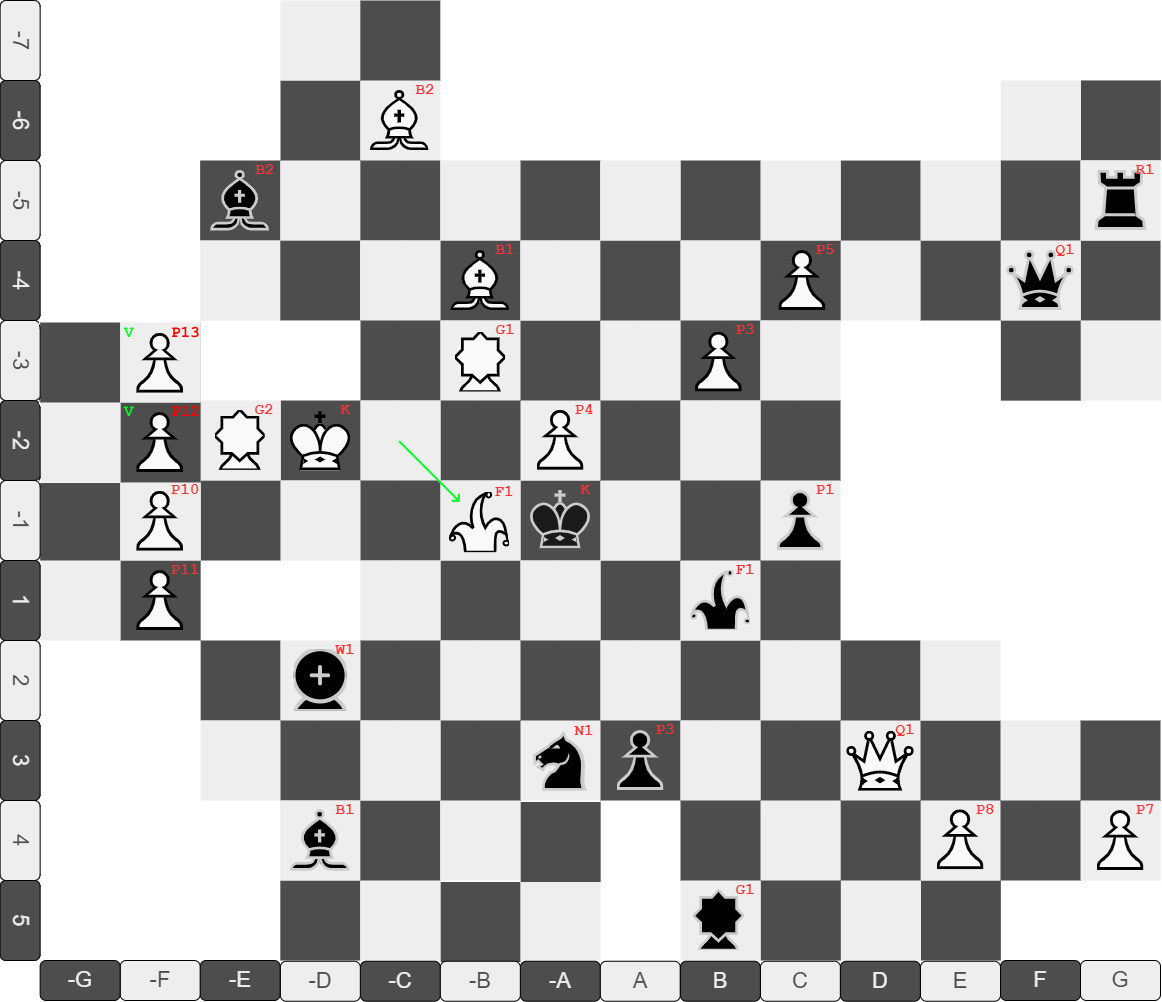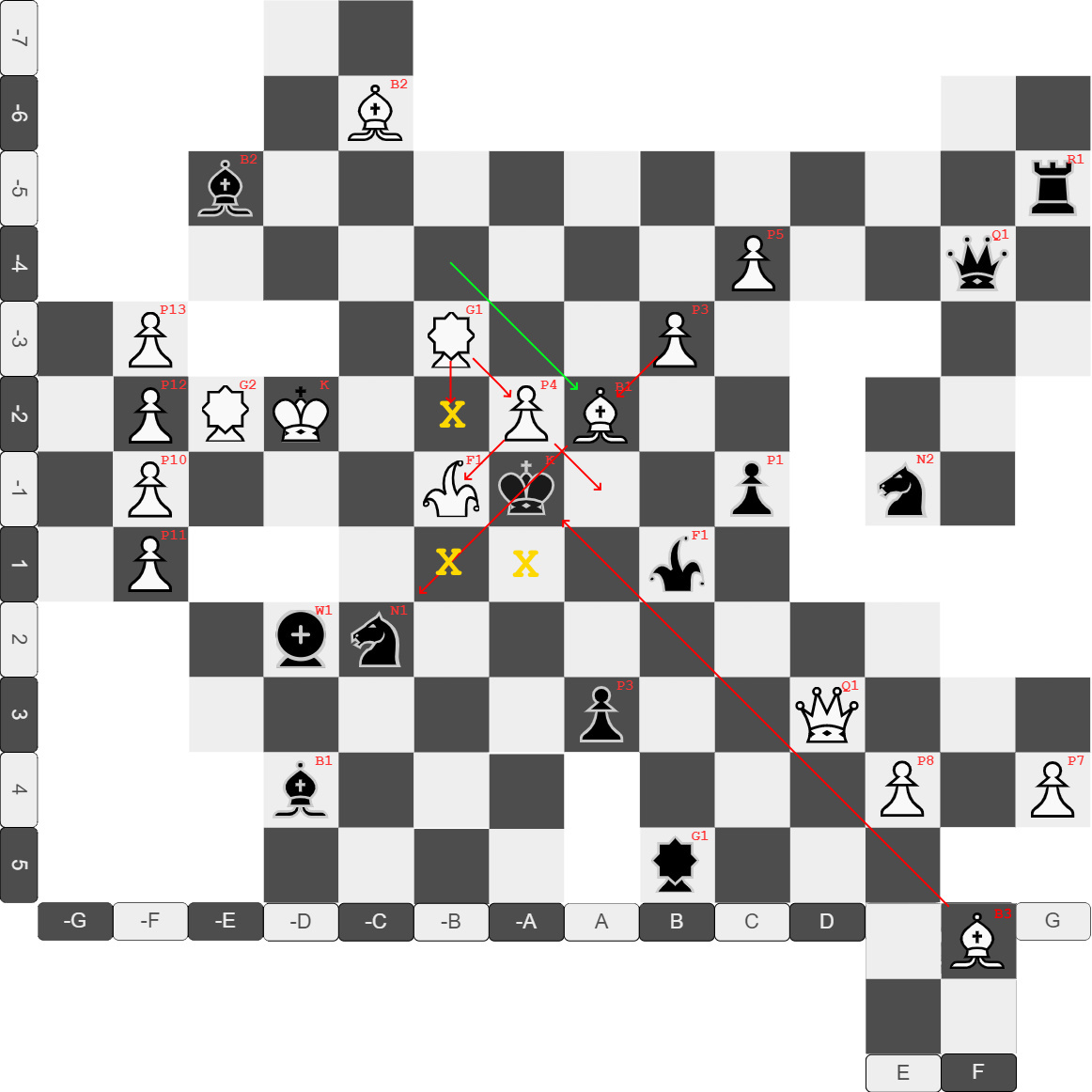- Location
- Canada
- Pronouns
- He/Him
This game is so fucking nutty I have no idea how any of this works but it is fascinating to watch.
Can a Fool moving like King place itself in Check?

Alas, tiles can only be placed where your pieces can reach, and no piece can reach -E4 or its whereabouts.
Can we even do that? Also why a rook there, to support bishop side?
...it's checkmate once the Black King retreats to A1 after the current move,Can we even do that? Also why a rook there, to support bishop side?
wP4 is there, and the bG1 is downwards, so the pawn covers it, as per the earlier clarification:
Unless I am mistaking it for something it isn't.A pawn can attack diagonally as long as one orthogonal directions bring it closer to the guard.
Ah, I see. It's no good then, as the blacks could move a Bishop and put white King in check, invalidating the threat from the Fool.Yes this is a valid move, the king is not however quiet put into check rather it becomes illegal for the king to remain in that position if they move any piece that can attack the king in that position. So they can't move the Wazir, Rook, Queen, or Guard.


Shouldn't it be B 4? It was B 4 last turn, and you spent exactly 3 points on a Knight while getting 3 points for the Guards.
Ok.The fool has moved the knight responds the great game moves forward but no threat exists at this time.
Shouldn't it be B 4? It was B 4 last turn, and you spent exactly 3 points on a Knight while getting 3 points for the Guards.
Remember the fool looses the knight move after you move so it doesn't threaten....I think that's checkmate. No?
The one branch I saw that didn't lead to an immediate checkmate was moving the Knight to B2, and then trying to threaten the king by placing Bishop at C-6 or something.
I don't get it.Remember the fool looses the knight move after you move so it doesn't threaten.

Wait.
I thought it was each Guard on the board. Not each Guard under their control?Each turn players gain one point for each guard on the board, they gain points from captured pieces as listed below. When creating a tile they can spawn in one piece using these points, or two if that piece is a pawn.
Sadly no. bB2 x wG1 evades the checkmate.
Chess uses Taxicab distance normally so yes on the moving to position.Edit: and a follow-up question. Can a pawn move behind the Guard? I.e. can a pawn that didn't move before make a double move and overshoot past the Guard? Would large "X" be a valid move if [wP] never moved before?
_X_| _o_
------------
_x_| bG
------------
wP |_x_
As for double move pass also yes.


Thanks for playing.
I was wondering - were you the one who played the game, or were you just the arbiter?
Was the game something that existed, or something that you came up with? I haven't heard about this variant before, but there is a lot of them floating around.
Some observations.
- The game puts massive emphasis on tactical positioning. You won't be moving most pieces once you place them, make it count.
- Checks are important, double checks are crucial. They make the opponent skip their moving turn, only acting on their "placement turn". You can sacrifice pieces so long as you can keep them in check -- you have more pieces than you'll ever need anyway.
- Pawns are OP. They move in up to 3 directions; attack in up to 3 different directions; can be placed in bulk; and their double move allows them to continuously expand the board. It's not coincidence I had 13 of them. I think they could use a nerf.
- Bishops are OP. Only 3 points to spawn a piece that can strike across the entire board, affecting piece placement in the enemy rear. Bishops were more instrumental to the victory than Queens. The value of a Bishop seems significantly greater than that of a Knight.
- Wazirs and Ferzs are... strange. I'd call them situational to the point of being unusable. One can checkmate a King with two Knights, or two Bishops, but how many Wazirs would you need on a regular, non-expanding board? They exist to wage warfare across gaps, but their movements are very limited, and their threat range non-existent. I'd say they'd be mildly useful priced at 2 points, and being able to attack into the same tiles they are able to move. The one Wazir this game was a Check threat, but never had the time to act on it and was only relevant because I made a mistake placing tiles around my King. Most such pieces would never have a chance to spawn close to the King to be threatening.
- Fools are a cool piece with great yet hard to predict potential. Love 'em!
Overall, this was pretty great. Do you have plans for more games? I probably won't be playing, but I'd like to observe and compare observations.